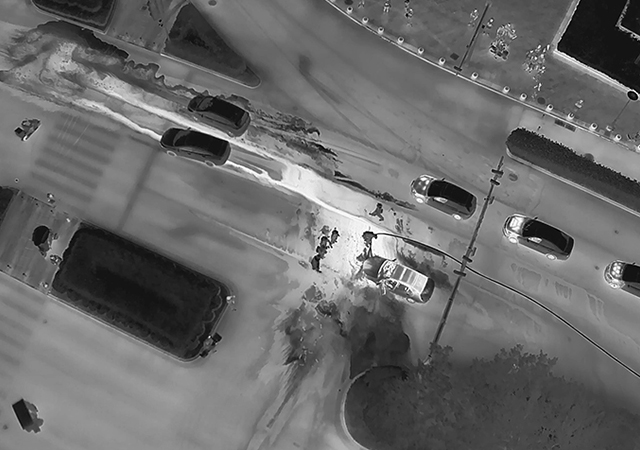A considerable number of traffic accidents occur because complicated road conditions cannot be detected in time, leaving the driver with insufficient reaction time. Thermal imaging night vision system can assist drivers to see road conditions ahead in low visibility conditions or even total darkness, and autonomously identify pedestrians, vehicles, animals, cyclists, etc. so that drivers could predict the location of vehicles, prevent danger in advance, and greatly reduce the occurrence of traffic accidents.

1) Working principle of infrared thermal imaging camera
A thermal imaging camera detects infrared energy (heat) in a non-contact way and converts it into an electrical signal, which then generates a thermal image on the display. An infrared camera is a detection device that can calculate temperature values. It accurately quantifies and measures the detected heat, allowing observers not only can see visible thermal images, but also can accurately identify and rigorously analyze the heating fault area.
2) What is Thermal Imaging Assisted Driving System?
Thermal imaging assisted driving system is a technology developed from vehicle-mounted night vision devices.
In the 1950s, in order to improve the night mobility of vehicles, equipment and instruments with night vision functions were installed on vehicles to move freely at night. The vehicle-mounted thermal imaging assisted driving system has infrared detection capability and can sense infrared rays beyond the visual range of human eyes.
The vehicle-mounted infrared night vision system has a wide range of uses. In the past, due to high prices, it was mainly used for high-end purposes. However, with the advancement of technology and the popularity of the market, the price is becoming lower and lower. It is possible for ordinary people to have a thermal imaging assisted driving system.
3) Why use the thermal imaging assisted driving system?
In order to drive at night, the road conditions are clearly visible within the distance in front of the car illuminated by the high beam. But there are always dangers lurking in the darkness ahead.
Despite advances in automotive lighting technology over the years, driving at night is still much more risky than during the day. Often times, when you see someone changing a tire on the side of the road, or a pedestrian or animal crossing the road in the lights, you are too late and caught off guard.
A questionnaire survey on drivers has conducted to rate the 30 or 40 electronic devices on the car according to their own preferences. The results of the survey showed that most drivers have feelings for the car night vision system.
The reason is that airbags and ABS can only work in emergency situations in the car, while the car night vision system is an active safety device, which can detect accidents early and prevent problems before they happen, greatly improving the safety of the car when driving in harsh weather.
The night vision system will help you see clearly the scenery outside the range of the headlights, so you have the foresight to discover potential dangers in the dark early, thereby greatly improving driving safety.
4) Vehicles that can use thermal imaging assisted driving system
-Passenger cars, commercial trucks, buses and recreational vehicles
Vehicle-mounted thermal imaging assisted driving system can detect dangers in advance, reduce the probability of accidents, and protect life, property and personal safety.
-Ambulance
The high speed and poor braking distance of the ambulance increase the probability of accidents, and the thermal imaging assisted driving system can also detect the danger in front of the vehicle at high speed.
-Passenger and freight trains
Thermal imaging assisted driving systems can detect obstacles on the railway at great distances in total darkness.
-Heavy-duty engineering vehicles
When used for heavy-duty vehicle navigation, the thermal imaging assisted driving system can improve the driver's perception when the camera that relies on vision and daylight imaging fails. By penetrating dust and smog with clear thermal imaging, the safety of pedestrians and vehicles can be ensured.
Go Top